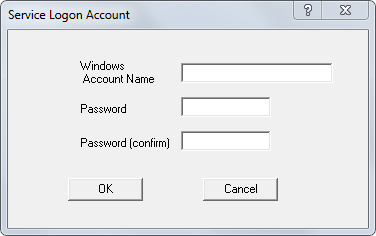Launch or switch to the Administration Utility.
Select the Server tab. Ensure that the Server is not already running.
Ensure that these components of the mvBase Server are fully configured within acceptable parameters:
Authorization
Virtual memory storage files
Processes and lines
Ensure that the Workstation has not been started (view the Workstation tab). Stop the Workstation if it has been started, as Workstation startup and connection should follow Server startup.
When starting mvBase Server as a service for the first time, the Service Status displays Not Installed.

In this case, select Install. The Service Logon Account dialog box displays.

This dialog box installs the mvBase Server as a service. Installation as a service allows the Server and the Workstation to be activated by the Service Control Manager during Windows system boot.
Define these features of the Service Logon Account dialog box:
Account Name |
Enter the account name under which to logon the service. The syntax of the account name is domain\user. The domain is any accessible domain on the network and may be omitted to select the default system settings. The user is any user defined for the Windows domain or local system. The user must be in the administrator group with administrator rights. |
Password |
Enter the user’s password. |
Password (confirm) |
Enter the password for the user to double-check for typing errors. |
Select OK in the Service Logon Account dialog box. A confirmation message indicating the service installed successfully displays.
Select OK in the confirmation message. The Server tab displays, and the Server Service status displays Stopped.

Verify that the Server Service mode is selected (highlighted) then select Start.
The Service Status reads Start Pending, then Running.

After you select Start, the coldstart process starts as a background process. When the mvBase Server starts as a service, the Autoboot option is always selected (on). The System Configuration dialog box does not display and an mvTerm client does not start automatically.
Select OK in response to the Service started successfully! message. The status changes to Running.
Close or minimize the Administration Utility if preferred. The Server continues to run until stopped via the :SHUTDOWN Proc, the Administration Utility or the Windows Task bar.
NOTE |
When you start the mvBase Server as a service, it does not automatically start an mvBase client connected to process 0. |